This is not an “MTG Finance” article. This is a Collection Building article. The difference is that MTG Finance focuses on strategies that turn a profit; Collection Building focuses on how to manage your collection in a way that gives you access to play the game that we all love and enjoy. I’ll admit there is some overlap, but collecting carries a completely different mindset, one that we’ll explore a more in this article. Let’s start by talking about the greatest Magic set ever released, Modern Masters 3 (MM3) 1.

When MM3 spoilers started dropping, the set was met with much praise, and it was well deserved. What’s not to love; great limited format, awesome rarity downshifts (pauper players rejoice), sweet new art (except Goblin Guide, sorry I’m not trying to be a hater, but let’s keep it real), and a mountain of much needed reprints.
With the introduction of Master sets, and supplemental products like the Commander Decks, reprints have been more common than in years past. As reprints increased, it seemed that there was still an invisible line that Wizards ofthe Coast (WoTC) was careful not to cross. That changed with MM3.The invisible line was totally obliterated! MM3 has significantly raised the bar for Master sets, and it is a clear indicator that WoTC has doubled-down on the initiative to meet demand for much needed reprints. This prioritization of meeting customer demand is revealed in Adam Prosak’s article about Damnation, where they bumped an “on-theme” card (Supreme Verdict) for Damnation. This up-tick in reprint momentum is exciting for some players, but rage-inducing for others.
For players who paid “full price” for cards included in MM3, there’s a “feels bad” moment when they realize they won’t be able to get that value back. Nobody wants to watch their $60 Damnation drop to $20, but this is indeed what happens when a fresh wave of supply comes in to meet demand. The frustration is understandable, and I’m not here to argue about how you should feel, or what is best for Magic as whole — that’s above my pay grade. Instead, I want to bring conversation to a local level, and try to answer this question, “What (if anything) can you do to protect yourself from reprints?”
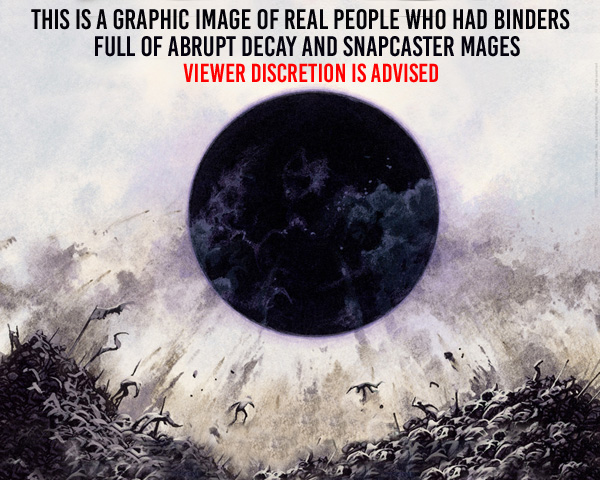
“Collectinvesting”
In order for this article to make sense we have to assume that your Magic collection has some kind of monetary value. What I don’t want to do is to look at your collection like an investment. I know, I know, this flies in the face of what many of you have been taught. But shifting your perspective can help you to enjoy playing your cards, instead of agonizing over “lost value”. Not to mention, there’s all kinds of cognitive dissonance that occurs when people hoard in the name of “making investments” — but that’s for another day. I think I just stepped in something that deserves a lot more unpacking, but I don’t want to lose the reprint focus. Let me leave it at this — You will be most successful, and most happy, if you pick one of these mindsets and remain consistent in it:
- I maintain a collection of Magic cards to play the game.
- I invest in Magic cards for profit.
This article is for those who choose to live in the first camp. I’ve already written quite a bit (in another life) for those who choose the second camp. Some might ask, can’t we have both? On the surface, it does seem like you can have both, but I think this is an illusion. There will come a moment, when a card rises in price, but it’s in your favorite deck. What do you do then? Whatever the answer is, that’s the true path you’ve chosen. No matter how long you go believing that you have both, underneath the surface one mindset always takes priority. My advice is to mentally commit to a mindset, either keep a collection for playing, or invest for profit 2. Now that we’ve got our mindset right, let’s chill out for some story time.
Story Time
Let's say one day you're in a griefer mood, you're bored with Standard, and you're watching Saffron Olive’s decktech on Madcap Moon! That’s typically all it takes to trigger an epic deck-building quest. Now you’re in build mode — you’ve cashed in your store credit, and spent most of FNM trading, you even called in some favors with the underground card cartel. One week later, you're ready to jam some games with your newly acquired deck. After three games, you realize "This deck is a hot DUMPSTER FIRE!" So you throw it in your bag, and decided to play some Commander instead.
Damage Control
Three months pass, and MM3 spoilers start to drop. It's a sad moment when you realize that you have a playset of Blood Moons and Snapcasters sitting in a Red UltraPro deckbox at the bottom of your bag. You take the deck out and thumb through to gauge the damage. “UGH! One of the Blood Moons was foil!” What can you do? This seems like a good place to talk about how to handle this situation, and how to keep yourself out of (as much as possible).
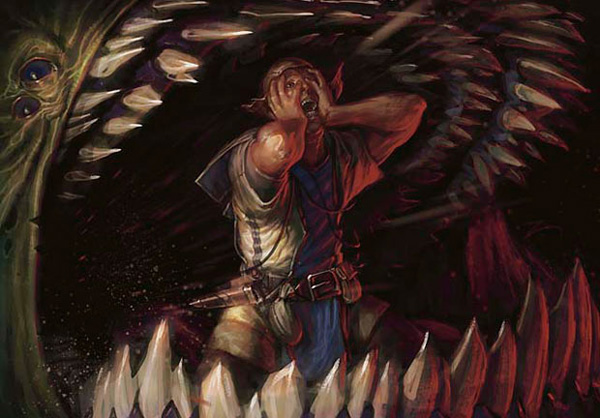
1) Don't panic!
Depending on the situation there's a good chance that the cards that were reprinted will "rebound" and the value of the card will recover. Price drops always happen with reprints in anticipation for the fresh supply. If those cards keep selling, then vendors will slowly raise the price to keep a respectable amount of inventory. If they continue selling, vendors will raise the price higher, incrementally, over time. If they sell out, then vendors will put the card on their buylist (this usually signals high demand). The opposite of this progression can also happen, where the vendors lower the price incrementally until the card starts to sell. No matter which way it goes, price recovery will depend on demand for the card. If there’s enough demand, any card can recover in price.
It’s important to note, that rarity also has a lot to do with price recovery. Rarity is directly connected to “supply” the higher the rarity, the lower the injection of supply is. This makes for quicker price recovery. If we take examples from MM3, this means that cards like Snapcaster Mage and Craterhoof Behemoth will recover faster than cards like Restoration Angel and Phantasmal Image. If you find yourself in a situation like the one in story time, then patience can go a long way. Waiting before doing anything with the cards might be the best move.
2) Trade Unilaterally
This is harder to do if the reprint is a "one-off" in a Standard set. It's much easier if the reprints come in batches like in the Commander or Master Sets. The concept is basically to trade reprinted cards for other reprints that you need. Trading one "devalued" card for another helps shield you from loss in the "exchange rate". Let's take our opening scenario for example. If you trade your now-devalued Blood Moon for a Damnation for your EDH deck, then it's like you got in a time machine, went back three months earlier, and traded a $40 card for $60. If you were to trade that Blood Moon for a Heart of Kiran, then you'd be trading that virtual $40 for a $20.
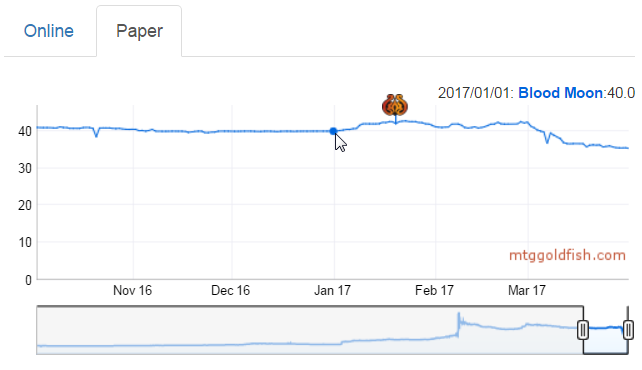
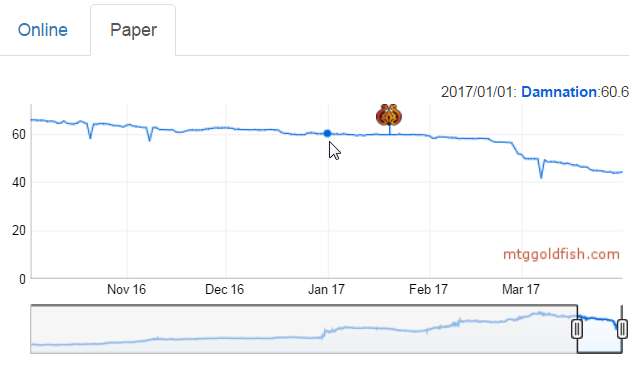
Another way to look at it is, by observing the practice of trading within formats. You might have met someone at who says something like, "I only trade Legacy cards for Legacy cards." The reason is because all Legacy cards are tied to the health of the format, so they rise and fall together based on how the format is doing. It is similar for the cards in the same set, they’re all tied together, and they rise and fall with the amount boxes that are opened. This rising and falling also extends to the original versions of cards that were reprinted. When the MM3 Blood Moon price recovers, so will your Eighth Edition Blood Moon. This goes hand in hand with the previous point, since most cards will have some amount of price recovery, trading unilaterally will allow you to benefit from the price fall without losing the price recovery momentum.
3) Sell then Re-buy
A lot of times the older printing will have a little bit more value than the reprint. It's not often that you'll find someone to trade a new version for the older version and give you the difference in value on top, but it's possible you can sell the old version and then buy the new version for cheaper. For example, the Planar Chaos Damnation is hanging out around $30 and the MM3 one is only $20. Check out the coin you can pocket by “downgrading” the foil to the MM3 version (the MM3 version goes for about $40)!
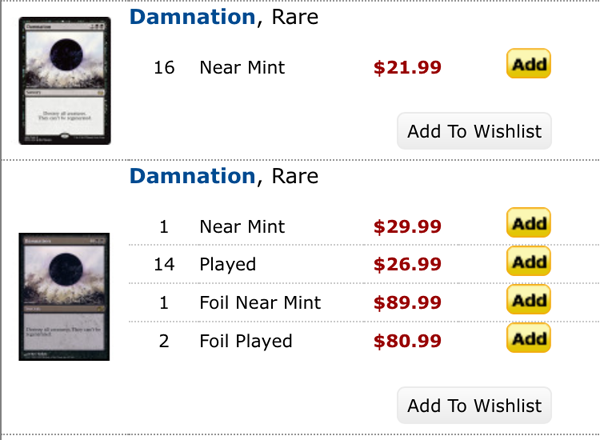
The cool thing is that by buying back into the new printing you still keep the momentum of price recovery. There are many more opportunities like this, but I don’t want to belabor the point. You can do some homework here, and we have a lot more to talk about so let’s sally fourth!
Hoarding Habits of the Typical Magic Player
I’ve been around the block. I’ve been a budget player, a collector of rare foils, a business owner, and a lover of this community. In all my dealings I’ve noticed something about most Magic players. We hoard things. I think there’s something psychological that happens as we collect, where we can’t seem to see how big our collections really are. Many Magic players think that their collections are pretty modest, but if you ask their significant other, or their roommate, they may say otherwise. I can’t count how many times I’ve sat down to buy someone’s collection, and they found it to be worth ten times what they thought it was. Somewhere in the five binders and two boxes of bulk was a fortune! As you can imagine, having all those cards opens you up to a lot of lost value when the reprints start to hit. Some of the best advice I can give you is to pare down your collection.

“What’s that!?” I’m glad you asked. Paring down is the process of decreasing something, it’s literal meaning is to cut away or cut off. That’s what we want to do with your Magic collection, cut away the excess and only leave the essentials. It can actually be pretty fun, because you get to dig through your collection. You can do this to whatever degree that you’re comfortable, but I recommend a brutal and bloody pare down. Here’s an overview of the process. Go through your place, and gather all the deck boxes, binders, and random containers of Magic cards. Set them on a big table or a clean floor, and begin to break them down. Starting with the decks pull out the staples you’re going to keep (more on thus below), and put the rest in the pare down pile. It might be good to invest in some of those sweet binders that hold playsets. After you go through everything, it’s a good idea to go through the pare down pile to make further cuts. Knowing what is essential and what is not comes down to knowing yourself.
Know Thyself
The better you know yourself as a player, the more effective the above process will be. My advice is to try to understand what decks you like to play, and what is required to play those decks. For example; I love to play Splinter Twin variants. This means that I’d keep all the cards to play Splinter Twin in Legacy (trust me it’s been done!), Kiki-Chord in Modern, and Four-Color Saheeli in Standard. A good tip is to sleeve all these decks in the same type of sleeves, then you can easily swap cards between decks so that you don’t have keep multiple playsets. This is another area where you can “trim the fat” — consider how many copies of a card you actually need. Unless we’re talking about basic lands, the number is not more than four.
This kind of advice is going to drive some people crazy, but remember we’re trying to reprint-proof your collection. Holding on to two playsets of Thoughtseize is not going to help you do that. Try to figure out what the optimal number of a card is for your collection. For example, you don’t need a playset of Rest in Peace. The correct number for most sideboard cards is between one, and three. The same is true of cards like Kolaghan's Command. Try to have solid reasoning for keeping cards, if your reason is “just in case” you should pare it down. It’s always good to keep the goal in mind when doing hard things. Remember, you’re not burning the cards in your pare down pile, you’re converting them into what I like to call freedom units!

Freedom Units
I like this phrase. Shout-out to my book reading, Lambo driving, friend, Tai Lopez. I like the phrase, because it’s a double entendre. In one sense, it means actual freedom — you own these cards, they don’t own you. You’re free to pare them down, and be OK in life. It also means that you just cut a huge chunk of value out of your collection, and now you’re free to do whatever you want with it. You can help a family member in need, take your significant other on a cruise, you can fill in some gaps in your essentials collection, or if you really want, you can distill this value in cards that won’t get reprinted, by trading for reserved list cards.
Distilling in Reserved List Cards
I’ll admit, we are getting dangerously close to “investment talk”. Some voices who talk about investing in Magic cards, like to talk about investing in the reserved list, but again I want to emphasize that we’re not looking to turn a profit. What we want to focus on is cards that you may need for playing that are also on the reserved list. Let’s say you went through the process above and built your essentials binder, but you need some eternal cards to complete some decks, this is a great opportunity to acquire those. This section is primarily for those who play EDH, Legacy, Vintage, or Old School — but I think anyone can benefit from understanding the philosophies talked about here. I could end this section here with a link to the reserved list and let you do some fishing, but I want to dive a little deeper and give you some reasoning for selecting some reserved list cards over others.
Above, I mentioned filling out some holes in your essentials collection with reserved list cards. Dual lands are some of the first cards to come to mind when considering this, and that’s a fine choice, but there might be better options. What if instead of dual lands for my Legacy deck, I picked up a Tabernacle of Pendrel Vale for my Five-Color lands EDH deck? The question now becomes, “What makes a Tabernacle a better choice than dual lands?” Before I answer that, let me say that we’re really splitting hairs here. Picking up the dual lands you need is fine, but if you want to be “safer” we can look at a concept that I call “Tiered Reasoning”. If I were to ask you to choose between a few of your favorite foods for dinner. How would you make that choice? It would probably consist of a chain of reasoning that would eventually result in your dinner choice.
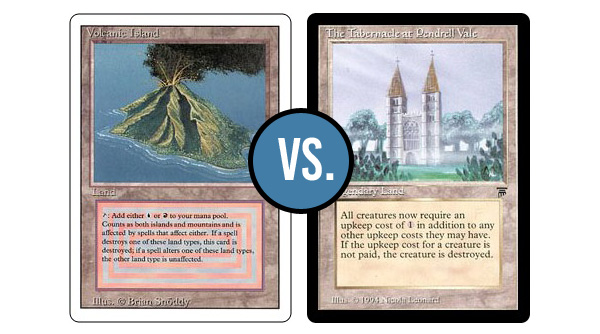
Tiered Reasoning
Let's look at this in action in regard to the reserved list cards. I say, if you don't want to be affected by reprints, distill your excess cards (the pare down pile) into cards on the reserved list. That is tier one, in the chain of reasoning. Tier one offers one level of protection. That means that you’re one-step removed from getting crunched by the machine. The second tier is this: get reserved list cards that you will play with. This protects you from getting a card, then quickly cashing it in because "you'll never use it”. Whenever you move value around in your collection, there is a cost. You want to avoid doing it more than you have to. This brings us to tier three, and why a Tabernacle is a safer choice than dual lands.
Tier three is to go with cards that have unique effects that would not likely be emulated or "done better" in the current state of Magic. The last time WoTC tried to do Tabernacle was on a four-mana creature (Magus of the Tabernacle). This is such a strong effect that I don't see WoTC repeating the effect at the same power level ever again. This means it's not likely to be replaced in the decks that use it. Dual lands on the other hand, are in the crosshairs of WoTC. Dual Lands don't do anything unique, they simply fix mana — albeit, the best fixing in the game. WoTC is trying all kinds of formulas to get close to these lands, there's even been talk about Snow Duals 3. If the original dual lands get replaced someday, then their pricing will take a hit in the same way they would be hit if they were reprinted. Trading into other more unique (in function) reserved list cards can help protect you if this were to ever happen.
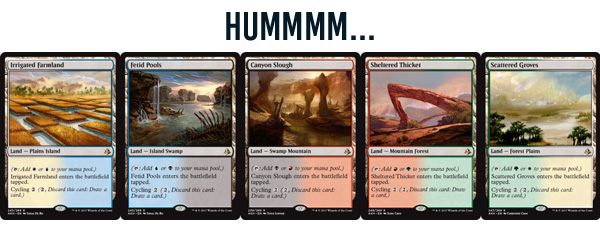
Landing the Plane
We just talked a lot about shifting the value in your collection around, to help mitigate or avoid losing value from reprinted cards. My hope is that some of these ideas will become second nature in the way you manage your collection, and that they will benefit you when future reprints come. Keep in mind that as part of the game, the value of your collection will fluctuate. If you’ve pared down, you can rest in the fact that you only have the essentials in your collection, and any monetary value lost, is actually just being converted into the value you get from playing the game.
Shout-Outs
I like to end each article by shouting out some people in the Magic community who do great work.
Sam Stoddard and Adam Prosak — Let’s thank these two madmen who were responsible for MM3!
Saffron Olive — This guys is a fountain of Magic news and information. If you’re not following him on Twitter, you should definitely do that. Or check out the website www.mtggoldfish.com
Thank you for reading! <3
Jonathan Medina
1 This is hyperbole.
2 I’m writing this to the average Magic player. Not to the storeowner who can maintain an inventory and a personal collection. But every storeowner knows that there’s no such thing as a personal collection when business calls.
3 This was actually written before the new Cycle dual lands were spoiled.
























